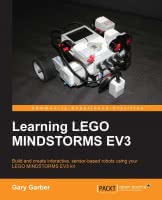Note: I've been one of the technical reviewers which finally has been published. This means that I also got a free evaluation copy provided by the publisher.
Review

Title: Learning LEGO Mindstorms EV3
Author: Gary Garber
First chapters include general mechanics knowledge, intro to how to create assembly instructions using LEGO Digital Designer or LDraw and some basic chasis using both the retail and educational kits. Not bad info, but we've already "eaten" more than 1/4 of the book. 4th chapter gives an overview of all EV3 sensors, which includes 3rd party ones, all with how to use them with the official LEGO EV3 software blocks. A chapter about how to interact with the brick (using the buttons and screen, wifi, bluetooth...), really basic stuff. Follows a chapter about types of output the EV3 (sounds, screen, lights), which is kind of introductory again (except the details of how to load custom images).
Chapter 7 is where the non-basic stuff appears, and from here onwards we see quite bigger examples (block schemas) and the book gets more interesting. Explanations are good, images help and we learn more interesting concepts like course corrections, triangulation and other navigation options. Chapter 9 includes data logging, but as is only available to the educational kit this restricts the possible interest (other than generating envy). The remaining chapters cover an introduction to RobotC, LabView, Bluetooth communication between two EV3 bricks and another education only chapter, a detailed explanation of the Gyro Boy robot.
The book is a mixed bag: Some chapters are quite interesting and the descriptions and theory behind are excellent, but others are either too basic or exclusively for the education kit. For a 263 pages book, this leaves out around half the pages as "interesting for everyone". Another complain is that some of the block images are really hard to read in PDF ebook; I still have to receive the printed copy, but I fear that without color it might be even harder to distinguish individual blocks in the complex diagrams.